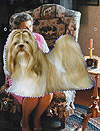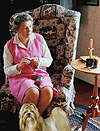| ISO 9000 | ISO 14000 |
 GMP Consulting |
This is a job for Local Undo. With a close zoom, and the Local Undo tool activated, we traced over the bicycle tires with a round nib the size of the tire. Here we have finished the first two tires, but not the third. You can see a distinct line where the tire meets the ground, and we’ll need to apply a bit of blend to it, if it is noticeable at normal magnification. Figure 25.13 is our final product, and it included the following:
A Woman Gets a Companion The woman in Figure 25.14 came from People and the dog from Pets. Her feet look like they are getting cold and the dog looks like it is dying to curl up next to them. Here is how this little operation will come down... First, the dog. Masking her is a study in backward thinking. As always, we look first to see if the Magic Wand could work because it is by far the swiftest of the masking tools. Using the wand on the dog would be problematic, what with all of the highlights and color shifts throughout her coat.
The background is much more consistent, even though it is the foreground that we want. We could mask the background and then invert the mask, but we have a better idea:
How, you might ask, could we unmask that which isn’t masked in the first place? Don’t ask—just do this:
In other words, you are telling PAINT: Take the mask away from any place I click—start with a mask everywhere and remove it from pixels that look like this (click). This is the digital equivalent of the sculptor’s advice about how to sculpt an elephant: remove everything that doesn’t look like an elephant. With a Tolerance of 25, one click removed the entire blue background. Two minutes of clean-up later, we had this. You’ll surely notice that the mask is inside the edge of the dog; this was intentional. We didn’t want any of the blue background to come with the dog on her journey, and the dog is so hairy and shaggy that, frankly, she won’t miss a little if it gets cropped out. Masks can be turned into floating objects several ways, and the simplest (especially when moving between images) is to copy it to the Clipboard:
As a floating object, the dog can be sized, moved, and most importantly, feathered. By feathering five pixels, she integrates nicely into the photo with her new master, as Figure 25.15 shows.
More on MaskingWe said at the beginning of this chapter that PHOTO-PAINT needs its own book. Well, masking could practically have a book onto itself. Here are a few other topics to explore on your own with respect to masks. Like a Mask, Save a Mask Masks can be saved in several ways. First off, if you save your work in PAINT’s native CPT format, any mask that exists in the image is maintained. When you reopen the file, you will see the familiar mask outline, or “marching ants,” as our friend and PAINT specialist Peter McCormick likes to call them. You can also save just a mask, for later use in the same image or a different one. Go to Mask Ø Save and then choose Save to Disk or Save As Channel. The former will save the image as a monochrome bitmap in any file format at all, with white pixels identifying the masked region and black pixels covering the rest. You can then load that mask into any image to activate it. Saving a mask as a channel keeps it internal to the file. Any image can be loaded into PAINT as a mask, even one that was not created for that purpose. When you do this, PAINT uses the image as a stencil—pixels that have color can be drawn on or filled, while pixels that do not are protected. Figure 25.16 began as the photo of Jamie being loaded in as a mask. Then we sprayed clouds on top of her. The sunburst at the top is also courtesy of the image sprayer, but we just clicked once.
|
|
|







